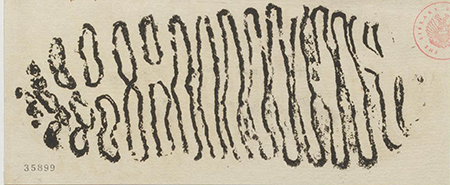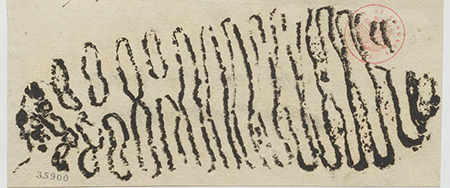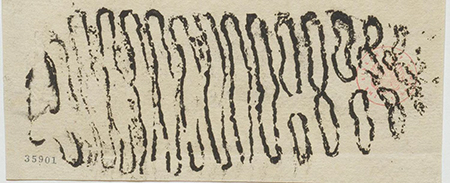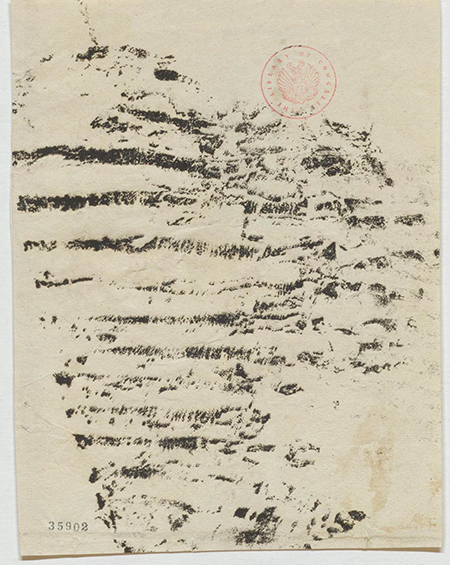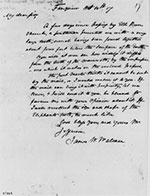 When James W. Wallace enclosed impressions of a fossilized tooth in the letter below and offered to send the tooth itself, he sought to contribute to what Thomas Jefferson called his "little collection of curiosities" at Monticello. Jefferson displayed several fossils in the Entrance Hall, some of which he had previously had excavated and sent to him from Big Bone Lick on the Ohio River. In his 30 Oct. 1817 response, Jefferson said he recognized the example from Wallace as matching others he had seen, which had been "pronounced to be the teeth of a genuine elephant." This America elephant, he explained, "is clearly distinct from what we have called the Mammoth, & Cuvier has denominated the Mastodont." Scientists often confused the fossils of these extinct species in the late-eighteenth and early-nineteenth centuries, even after Georges Cuvier differentiated them in 1806 based on the shape of their molars. The impressions Wallace sent here were in fact from the mammoth, a member of the elephant family, whereas the Big Bone Lick fossils included specimens both of the mammoth and the distantly related mastodon.
When James W. Wallace enclosed impressions of a fossilized tooth in the letter below and offered to send the tooth itself, he sought to contribute to what Thomas Jefferson called his "little collection of curiosities" at Monticello. Jefferson displayed several fossils in the Entrance Hall, some of which he had previously had excavated and sent to him from Big Bone Lick on the Ohio River. In his 30 Oct. 1817 response, Jefferson said he recognized the example from Wallace as matching others he had seen, which had been "pronounced to be the teeth of a genuine elephant." This America elephant, he explained, "is clearly distinct from what we have called the Mammoth, & Cuvier has denominated the Mastodont." Scientists often confused the fossils of these extinct species in the late-eighteenth and early-nineteenth centuries, even after Georges Cuvier differentiated them in 1806 based on the shape of their molars. The impressions Wallace sent here were in fact from the mammoth, a member of the elephant family, whereas the Big Bone Lick fossils included specimens both of the mammoth and the distantly related mastodon.
A few days since passing by Elk Run Church, a Gentleman presented me with a very large tooth, several having been found together about four feet below the Surface of the Earth.
You will at once see how widely it differs from the tooth of the mammoth, by the impressions which it makes on the enclosed papers.
the post master thinks it cannot be sent by the mail, or I would enclose it to you. If the mail can bring it with propriety, let me know, & I will send it to you. be pleased to favour me with your Opinion about it. If I well recollect the size and shape of the Elephants tooth, tis much like.
God bless You, and Yours Mr Jefferson.
James W. Wallace’s Impressions of a Mammoth’s Tooth
Impression by the upper Surface
Impression by the Upper Surface
Impression by the Upper Surface
Impression made by the side of the tooth
Letter: RC (DLC); endorsed by TJ as received 18 Oct. 1817 and so recorded in SJL. RC (DLC); address cover only; with PoC of TJ to John Barnes, 5 Jan. 1818, on verso; addressed: “Thomas Jefferson Monticello”; stamped; postmarked Fauquier Court House (now Warrenton), 10 Oct.
Enclosure: MS (DLC: TJ Papers, 202:35899–902); captions in Wallace’s hand, with each impression on a separate piece of paper; undated.
elk run church was a community located in Fauquier County.
COPYRIGHT NOTICE: Published by Princeton University Press and copyrighted, ©, by Princeton University Press. All rights reserved. No part of this book may be reproduced in any form by any electronic or mechanical means (including photocopying, recording, or information storage and retrieval) without permission in writing from the publisher, except for reading and browsing via the World Wide Web. Users are not permitted to mount this file on any network server.

